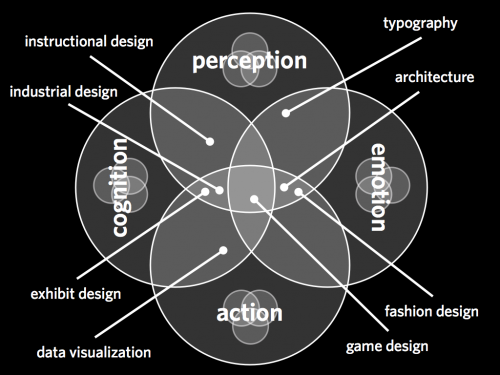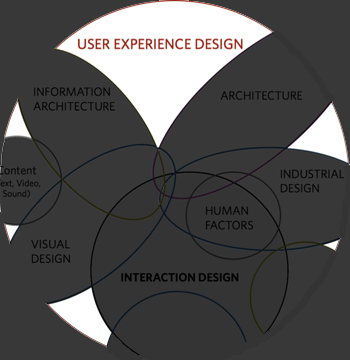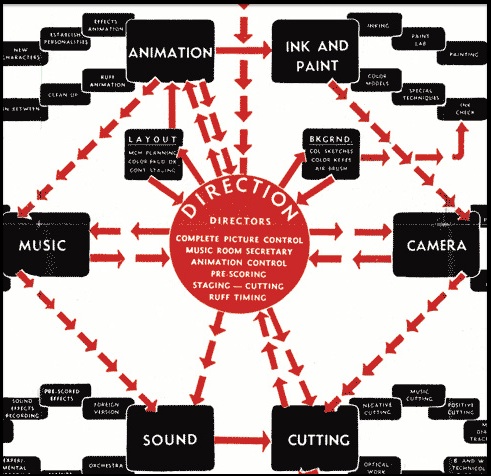I was asked to speak at UX Week 2012, and figured I’d turn my blog post “User experience is strategy, not design” into a talk, but a funny thing happened along the way. I realized that, yes, UX is design, but not design as we’ve been thinking of it. And by reframing “UX design” as a profession, we can set it up to uniquely address increasingly prevalent business needs.
Before tackling the profession, we need to agree on just what “UX design” is. I have not come across a better definition than Jesse’s, which he originally shared in 2009:
Experience design is the design of anything, independent of medium, or across media, with human experience as an explicit outcome, and human engagement as an explicit goal.

Similarly, Dan Saffer attempted to diagram the scope of user experience design:

These both present very broad mandates. This is particularly vexing for those who see design as execution, as making stuff, Because how can anyone be expected to execute on all that? How can UX design as a profession address the enormity of what it encompasses?
And I think the issue is that we haven’t been able to see the forest for the trees. UX design isn’t all of those disciplines. UX design is not design-as-execution. UX design is what’s left.

What’s more, Jesse’s and Dan’s diagrams are overly design-oriented. User experience arises from the sum total of interactions with a organization’s products and services. If we take Jesse’s definition to heart, we need to recognize that just because UX emerged from software and grew on the web, that doesn’t mean it has to be digital. User experience is affected by business development, marketing, engineering, customer service, retail, as well as product and service design.
An analogous model for UX design
The challenge for the UX designer is to identify where, how, and at what level to engage in order to appropriately address this scope. Typical “UX design”– workflows and wireframes– is insufficient. It needs to embrace a much broader potential that drives outcomes through deep organizational engagement.
I propose that we think of UX design in a manner similar to film direction. To explain what I mean, look at this org chart from Walt Disney (I’ve zoomed in on the pertinent area).
A film director doesn’t “do” anything. All of the execution is carried out by specific craftspeople. The job of the director is to coordinate, to orchestrate these activities in order to deliver on a singular vision. The director likely came up through a specific craft (writing, acting, editing, cinematography), but through experience and vision, has come to lead across all these functions.
I propose that the profession of the UX Designer is analogous to the profession of the film director, coordinating across all those disciplines identified in the diagrams (and undoubtedly other activities).
(It’s worth calling out that Dan mentioned something similar in the post supporting his diagram, but he was somewhat dismissive about the role of the creative director, saying there wasn’t much to it, and that it was a temporary role.)
What this means is that UX Designer is not a workflows-and-wireframes role. It’s a leadership role (though not necessarily a management role). It is a systems role — UX brings humanity to systems design and engineering. UX is a fundamentally synthetic role, not just coordinating these distinct activities, but helping realize a whole that is greater than the sum of the parts. And while a UX Designer uses design approaches, they are not for typical design outcomes.
So, what does this person do?
The UX Designer doesn’t sit in a chair and shout “action!” (Actually, neither does the director. That’s usually what an assistant director does.) In order to support the orchestration of organizational resources to deliver great experiences, there are a set of activities I see UX designers leading.
User Insights
At the heart of great user experience is a deep understanding of the user, and the UX Designer should lead the development of insights that will help a company deliver better experiences. I’m calling out “user insights” distinct from “user research” — not all user insights are gleaned from user research, nor should the UX Designer necessarily be the user research lead. If user research is being conducted, the UX Designer should make sure to understand it well enough to be able to understand and prioritize the insights which will subsequently drive the design and development work.
Ideation and Concept Generation
Driven by user insights and other sources of inspiration, the UX Designer leads the team in coming up with ideas and concepts to address user’s behaviors, motivations, and context. There are many ways this can happen — sketching, brainstorming, bodystorming, improv, prototyping. The UX Designer identifies the most productive approaches, and then, as ideas emerge, filters out the less effective ones, and helps refine and evolve the great ones.
Experience strategy and vision
Perhaps the single most important responsibility for the UX Designer is to develop a clear experience strategy, and craft a compelling vision. An experience strategy specifies how a product or service will be successful from the perspective of user experience. A common part of experience strategy are design principles that help drive decision making.
Essential to helping a team understand how to realize an experience strategy is the creation of an experience vision. An experience vision provides a ‘north star’ for the product development team, helping them understand where they’re heading, and inspiring them to get there. These often take the form of prototypes — my favorite experience vision is Deborah Adler’s masters thesis for a new kind of pill bottle, dubbed SafeRX, which lead directly to Target’s ClearRX. I’ve had some success with illustrated scenarios of future experiences (either hand-drawn, or photographed). “Concept videos” inevitably seem like overkill and are usually never worth it.
Experience planning
It’s not sufficient to simply have a vision. And it’s typically not feasible, nor desirable to hold out on launching something until the complete vision can be realized. A UX Designer develops a plan for how to get from a current state to this desired future. What are in V1, V2, V3 along the way to the promised V4? Brandon’s Cake Model of Product Strategy shows how experience planning differs from typical product planning, because of its insistence on something experientially desirable at each stage.
Team Facilitation
While a visionary and a leader, the UX Designer must be a strong facilitator as well. There’s no way one person is going to have all the best ideas, so it’s up to the UX Designer to get the best from a broad, cross-functional team. Facilitation is less a discrete activity than a responsibility throughout a project. There will be a lot of things activities to facilitate, including branding exercises, customer value proposition articulation, tangible futures, and ideation and concept generation.
Oversight and coordination
This is the ongoing making-it-real of the experience strategy and vision. The UX Designer engages throughout the entire process, and makes sure that the user experience is never being compromised. If circumstances arise that force changes, the UX Designer leads the discussion to make sure that the new solution still adheres to the overall strategy. The UX Designer must sweat every detail, and, yes, occasionally be a jerk about it. As Charles Eames said, “The details are not the details. They make the design.”
What does this all mean?
My call for making the UX profession a strategic, planning, and coordinating one is not original. Here’s how Donald Norman, who coined “user experience” as we now think of it, framed it in 1995:
We describe the role of the “User Experience Architect’s Office”, which works across the divisions, helping to harmonize the human interface and industrial design process across the divisions of Apple and ATG.
The need Don recognized 17 years ago not only still remains, but is far more acute. As we’ve shifted from a world of standalone products to one of connected services, the increased complexity only makes poorer experiences likelier to arise.
Most people calling themselves “UX Designers” are not. They are interaction designers and information architects. These are perfectly laudable practices in their own right, but if “UX Design” is going to contribute meaningfully in this connected world, it can no longer be bound up in the constituent disciplines from which it emerged, but instead must embrace a new mandate to ensure the delivery of great user experiences regardless of where those experiences take place.

Fantastic! I absolutely love this. The only thing that I would add is context. All three of the visualizations are immersed in a cultural context that shapes the value of an experience, as well as the meaning drawn from it. The notion of user insights touches on it, but I believe that cultural insights (in the anthropological sense) are also critical to experience design.
Brilliant. Love the negative-space framing.
I would include some aspect of measurement/evaluation into the Oversight and Coordination activity (or as a separate activity).
Peter, thank you for this insightful definition.
When we aim to communicate to clients the aspects of “UX Design” (and the need for quotes is part of the issue you’re highlighting) that move beyond boxes and arrows we’re typically framing it as “Brand Strategy”.
Clients usually understand that their brand is an experience, so it is within a brand strategy framework that we can discuss experience across all customer touch points, not just HCI/UI.
Nicely articulated, Peter. A very welcome attempt to substantiate the true meaning of this heightened level of practice.
The film director analogy may get dismissed as overreaching by some but I think its spot on, mainly because the broader implication of UX Design is in its evolving impact on human culture.
Much like the filmmaking, its perhaps more manageable to focus on the mechanics rather than the story being told much less assert a purposeful argument that will shepherd it through a rigorous design process. Given the nearly instantaneous reworking of some storied movie franchises these days, perhaps the two fields have more in common than folks want to believe.
Doubtless Peter’s framework will be debated and that’s a good thing. I’m inclined to see these stirrings as both a maturation and a morphosis to a profession deserved of both. Good time to be a UXer regardless of stripe!
Maybe the UX Design role described in this post is similar to an Architect rather than to a movie director.
Following the reasoning of this post we could even think about two different roles: a UX Architect, who defines the UX strategy and the system vision from research and insights, and a UX Designer who designs the UX touchpoints.
Anyhow I fully agree with the general view: UX design should embrace and combine all the physical and digital components and processes which enable the user experience, across every context, channels and touchpoint. Nonetheless put in this way UX Design looks very similar to Service Design. What is the difference?
I don’t see this as a reframing at all. What you have described is how UX should and ought to work. The pretenders will have their clients believe that UX is something that happens during a process, like a step to be ticked off along the way.
UX is not and cannot be a layer inside a design process. For it to be a honest and valuable discipline, it must be all encompassing – soup to nuts – and run through the product at every single touchpoint from code level through to how a customer service agent greets you. That cant be described with a diagram which I guess is why most of the diagrams attempting to do so only serve to reinforce the silos.
Alex is correct. This is a very good and valuable commentary on how an experience-led design methodology should be manifest with organisations so, for those already following this path (rather than web/software user interface designers who’ve just changed a couple of letters on their résumé), this is a clarification more than a re-framing. All good points though!
So, how does this UX designer role you outline distinguish itself from, or dovetail with the Product Manager role? http://www.svpg.com/the-product-manager-contribution/
In all my years working in technology, I have never come across a UX Design position that comes even remotely close to this job description.
It’s a nice dream, though. Perhaps the title of this post could be changed to: “If Everyone I Work With Decided I was the Boss From Now On” or how about “If UX Designers Ruled the World”.
🙂
This is a great description of the way UX Design should be done. Too many projects are run as a quick fix or an isolated change/build without consideration of the context of the larger customer experience. The one thing I would add is that the UX vision should state how it is fulfilling the business vision/mission. Making that link explicit will help folks outside of UX to see its value.
Regardless of the name applied to it, this describes a very important role. The service design folks in the early 2000s — in making the case fo how service experiences and social platforms are distinct from product experiences and require a different approach — understood this definition to be the role of the service designer. Instead of using Film Director as the analogy, we used Choreographer, because it moved the association away from “manage/control” toward “facilitation/coordination.” I’ actually like calling this role “UX Designer”, but inside the organization I’m in, the understanding of the UX designer as interaction designer is already so ingrained, that we’ve had to find a new name… experience design strategist (ugh).
Hey Peter,
I’ve always seen it this way.
Even after defining User Experience in ISO 9241-210, I don’t differentiate UX Design from the practice of Human Factors.
Human Factors professionals are multi-disciplinary generalists who usually coordinate a team of specialists on a project.
Wikipedia defines it succinctly: “Human factors and Ergonomics (HF&E) is a multidisciplinary field incorporating contributions from psychology, engineering, industrial design, graphic design, statistics, operations research and anthropometry.”
User Experience Design, in fact all Human-Centred Design should have a generalist who can appreciate all aspects and allocate resources accordingly – an architect of the experience (thus, Don’s User Experience Architects).
Cheers,
Ash
You have a number of diagrams, any chance you could link to the sources as attribution? I’d like to read the previous conversations…
The perception, emotion, cognition, and action diagram cannot be linked, because it comes from a presentation Jesse gave. It’s never been written up.
Dan’s diagram attributed in the link above it:
http://www.kickerstudio.com/blog/2008/12/the-disciplines-of-user-experience/
The Walt Disney org chart is attributed in the link above it:
http://www.atissuejournal.com/2009/08/07/walt-disney%E2%80%99s-creative-organization-chart/
Brilliant!
This is kick ass, Peter. I have explained so many parts of this so many times, but never as nicely packaged as you have here (and never with the film director analogy in my head, which is great). Thank you.
Peter, I love that you continue to find purpose in the words. Words in fact do mean something!
My comment may seem out of place, but why do you torture yourself trying to redefine a profession? Design and Management have been around over a century. Those negative spaces you have captured in your diagram communicate the sweet spot of design.
Great designers understand that those gaps are where the magic happens. Great managers understand that ideas need pollination across groups. They also know great ideas emerge when people are encouraged to color outside the lines.
If we want to define design management as ux design, we’re really just adding a ton more work to explaining the value design plays in organizations.
I still vote for capital “D” design!
Nicely written, but this really starts to butt up against what Product Management does. I’ve worked agency and client side, in UX, Marketing and Product Management roles… and the way I see UX today is largely as a consultancy/agency service offer. However client side, it’s the Product Manager who has the job description closest to what’s been described in this post. They are the film director, not the UX person.
Nicely articulated, especially the points around cognition and emotion! I agree with several of your points as my perspective is similar. This role is approached differently throughout each company as some have a single person consulting about the UX part time where as other companies have UX teams, even UX teams per project, working within the Agile, Lean or other product development methodologies.